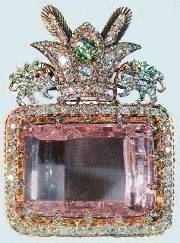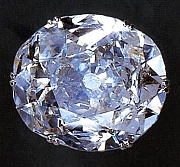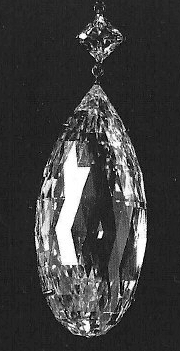Description The hardest of all gemstones and with the simplest mineral makeup: pure carbon. History Unconquerable Force Deriving its name from the Greek word adamas, meaning "unconquerable," diamond is 140 times more durable than ruby and sapphire. In ancient times, diamond was not valued as a decorative stone but as a stone used for cutting and shaping other stones. Ancient Greek philosopher and author of the first encyclopedia of natural history, Pliny the Elder, wrote of diamond’s hardness:
Diamond Powder Diamond powder was used since the time of Alexander the Great as an abrasive to carve and polish other hard gemstones, such as sapphire and carnelian. Diamond powder, which was made in India and packed in oil, was an expensive commodity that was widely traded along ancient trade routes. Diamond Trade Today Today, more than 80 percent of the diamond trade is controlled by an enterprise known as De Beers. Antwerp holds the largest and most important diamond trading exchanges in the world. Folklore Protection from Everything A Medieval philosopher/theologian, Albertus Magnus, wrote extensively on the properties of many minerals, including diamond. In his treatise on the then-known properties of minerals he wrote of the great protective powers of diamond:
Dreaming of Diamond In Victorian times, dreaming of diamond was said to foretell of victory over ones enemies. The Koh-i-Noor This 106 carat diamond, known as the “Mountain of Light,” was said to be worn 5,000 years ago by the Egyptian hero Karna, the mythic son of the Egyptian sun god. The Koh-i-Noor was later revered by the moguls of India as a symbol of power and authority. The Koh-i-Noor along with the rare pink 180+ carat Darya-i-Noor, the “Sea of Light,” was stolen from India in 1739 and later given as a gift to Queen Victoria. It graces the British Royal Crown jewels today. The Tiffany Diamond This famous 128+ carat canary-yellow diamond has been a symbol of Tiffany & Company for over a century. Famous 19th century jeweler Charles Lewis Tiffany bought this magnificent South African diamond in the late 1800s for $18,000. A team of skilled jewelers took nearly a full year to cut its 90 facets. In 1950 Tiffany designer Jean Schlumberger designed the iconic “Bird on a Rock” setting, which is seen to this day on display at the Tiffany & Co headquarters in New York. The Briolette of India One of the most infamous of all the great diamonds, the 90+ carat Briolette of India, may be the oldest diamond in history. The Briolette of India: Richard the Lionheart The long history of the Briolette of India begins with Richard the Lionheart, who reigned in England from 1189 to 1199 AD. King Richard I was no doubt a believer in the great protective properties of the diamond, later written of by Albertus Magnus, but rather than protecting its owner from harm, the Briolette left a trail of tragedy. The Briolette of India: Trail of Tragedy In 1190, Richard I embarked on the First Crusade to the Holy Land, and, for good luck, he brought the Briolette along. On his way to Jerusalem he became ill and had to stop to rest. While he was away his brother John seized power in England. At an impasse with the Turks and too sick to go on, he turned back to England, without having seen Jerusalem. On the way back home, he was captured by the Duke of Austria and locked up, as an enemy of the German empire. After two years Richard was finally released to go back to England. After carrying the Briolette for nearly a decade and losing power, surviving illness, capture, and imprisonment, Richard the Lionheart was fatally wounded while fighting in France. At this time, it is believed that the Briolette was stolen and landed in the French royal treasury. The Briolette of India: 800 Years of Mystery Four Hundred years later we see a glimpse of the Briolette in a portrait of Diane de Poitiers, who was a beautiful young mistress of Henry II of France. The Briolette of India disappeared again for another 400 years. It finally reappeared in 1950 when New York jeweler Harry Winston bought it from an Indian Maharajah. Symbolism Hour: 12:00 PM (noon) Birthstone, modern: April Seasons: Wedding anniversary, traditional: 10th, 60th and 75th Angel: Michael Star: Caput Algol 18º of Taurus Planet: Jupiter and Moon US States: Canadian Territory: Northwest Territories Countries: England, Holland, West Africa and South Africa |
|






